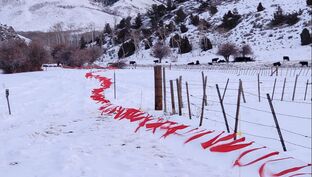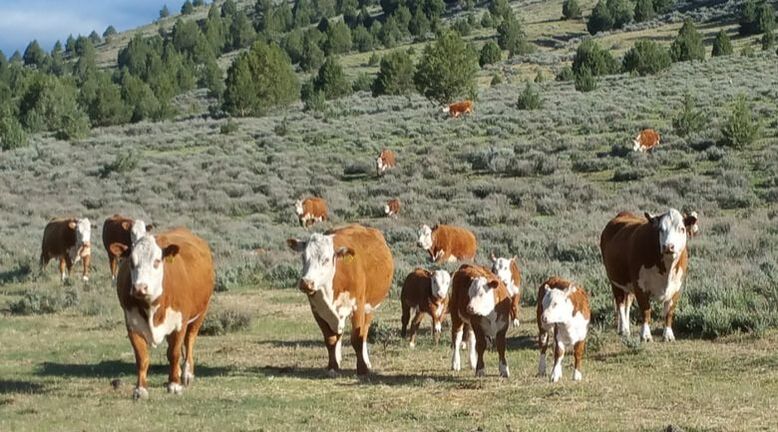WORKING CIRCLE
Feeding:
Feeding during calving season holds one of the highest potential predation risks. Wolves are keen on recognizing vulnerability in potential prey and quickly learn to take advantage of any patterns in livestock management that create a window for increased prey or cattle vulnerability.
For example, when feeding hay during calving season, wolves can learn to listen for the tractor in anticipation of the cows leaving their bedded-down calves to follow the tractor and feed. The cows, often checked out for hours while feeding, leave their calves behind unattended and vulnerable to wolves.
Here are some basic ways to minimize this risk.
The combination of having a rider pick up the calves and evening feeding has proven to be a successful strategy in reducing the potential for conflict.
Pasture/Lot Rotation
Simply changing the scene can help reduce wolf predation during calving season. Wolves will associate a place with hunting success or potential for food gain if the vulnerability in prey is higher than the risk to the wolves (by their perception). Changing up the scene by rotating calving pastures or moving calving pastures 1-2 miles can reduce the potential for conflict.
Fencing
If a regular/permanent annual pasture for calving is used, installing multi-strand high tensile wire fencing (HOT!) around the perimeter of the calving pasture has shown to be nearly 100% successful in keeping wolves out. This is an expensive option initially, but long-term can reduce the potential for predation significantly and reduce the need for continued human presence other than what is part of your regular practice in terms of day/night calvers and feeding.
Terrain
Wolves learn to take advantage of terrain features. Many predations occur in narrow draws, steep-sided creeks, bogs, downfall, wooded areas, and fringe territory. In addition, wolves may run their prey up against fencing.
A pasture located in a defensible open terrain with minimal characteristics that wolves can take advantage of will help reduce the potential for conflict. This may be easier said than done. However, being aware of the landscape and considering what features may increase vulnerability in cows and calves will help you create a calving strategy that works to manage the risk potential.
Human Presence
A human presence, day and night calvers, or simply a watch setup can be an effective strategy during the calving season. Changing the location of human presence or work pattern/schedule may increase effectiveness – wolves will learn patterns and times of human activity and take advantage of that awareness. Lights that can be flashed (flashlight or other) may help to enhance the effectiveness of human presence at night. HAZING: Hazing that does not have the potential to harm a wolf (non-injurious) is currently allowed in Colorado. Using airhorns or other noisemakers and lights may deter a potential threat. Hazing in any form should ONLY be done if wolves are in the cattle OR stopped just outside the fence line and eyeing the cattle. If wolves are simply passing by, leave them alone. For hazing to be effective, wolves must associate the mental discomfort directly with the cattle. Once the wolves start to move out and away from the cattle, any hazing pressure should be released.
Feeding during calving season holds one of the highest potential predation risks. Wolves are keen on recognizing vulnerability in potential prey and quickly learn to take advantage of any patterns in livestock management that create a window for increased prey or cattle vulnerability.
For example, when feeding hay during calving season, wolves can learn to listen for the tractor in anticipation of the cows leaving their bedded-down calves to follow the tractor and feed. The cows, often checked out for hours while feeding, leave their calves behind unattended and vulnerable to wolves.
Here are some basic ways to minimize this risk.
- Have a rider present: have the rider (or someone on foot) pick up the calves behind the cows to ensure they stay together and go with their mothers. This alone will reduce vulnerability to predation significantly. .
- Feed in the evening: Once cows are done feeding, they will more likely bed down together in a group vs. scattering. With their calves already nearby, this further encourages the herd to remain tighter during the night. Night feeding also leads to a higher percentage of calves being born in daylight hours vs. the night; this makes calving management easier, and births in the daytime reduce vulnerability to predation to both cow and calf.
The combination of having a rider pick up the calves and evening feeding has proven to be a successful strategy in reducing the potential for conflict.
Pasture/Lot Rotation
Simply changing the scene can help reduce wolf predation during calving season. Wolves will associate a place with hunting success or potential for food gain if the vulnerability in prey is higher than the risk to the wolves (by their perception). Changing up the scene by rotating calving pastures or moving calving pastures 1-2 miles can reduce the potential for conflict.
Fencing
If a regular/permanent annual pasture for calving is used, installing multi-strand high tensile wire fencing (HOT!) around the perimeter of the calving pasture has shown to be nearly 100% successful in keeping wolves out. This is an expensive option initially, but long-term can reduce the potential for predation significantly and reduce the need for continued human presence other than what is part of your regular practice in terms of day/night calvers and feeding.
Terrain
Wolves learn to take advantage of terrain features. Many predations occur in narrow draws, steep-sided creeks, bogs, downfall, wooded areas, and fringe territory. In addition, wolves may run their prey up against fencing.
A pasture located in a defensible open terrain with minimal characteristics that wolves can take advantage of will help reduce the potential for conflict. This may be easier said than done. However, being aware of the landscape and considering what features may increase vulnerability in cows and calves will help you create a calving strategy that works to manage the risk potential.
Human Presence
A human presence, day and night calvers, or simply a watch setup can be an effective strategy during the calving season. Changing the location of human presence or work pattern/schedule may increase effectiveness – wolves will learn patterns and times of human activity and take advantage of that awareness. Lights that can be flashed (flashlight or other) may help to enhance the effectiveness of human presence at night. HAZING: Hazing that does not have the potential to harm a wolf (non-injurious) is currently allowed in Colorado. Using airhorns or other noisemakers and lights may deter a potential threat. Hazing in any form should ONLY be done if wolves are in the cattle OR stopped just outside the fence line and eyeing the cattle. If wolves are simply passing by, leave them alone. For hazing to be effective, wolves must associate the mental discomfort directly with the cattle. Once the wolves start to move out and away from the cattle, any hazing pressure should be released.
Tools
Turbo Fladry, Foxlights, and RAG (Radio Activated Guard) boxes (if available) may provide effective though short-term protections. And in more extensive pastures, some of these tools may not be reasonable to use due to costs, terrain, or miles needed to be covered.
For Grazing Season
In open range, strategies based on herd management and grazing practices combined with specific stockmanship techniques and an understanding of wolf hunting behavior have demonstrated sustainable and long-term success for landowners in not only reducing vulnerability in cattle to predation but in increasing ranch economic viability and resiliency.
There is no perfect solution to reduce wolf-livestock conflict. However, strategies have evolved, been discovered, and come a long way, especially over the last ten years. Being proactive in working to prevent conflict vs. working reactively after a conflict occurs is by far the smarter and more effective approach. Feel free to reach out with any questions or for more information on support and resources available. We are here 24/7/360.
Turbo Fladry, Foxlights, and RAG (Radio Activated Guard) boxes (if available) may provide effective though short-term protections. And in more extensive pastures, some of these tools may not be reasonable to use due to costs, terrain, or miles needed to be covered.
- Turbo Fladry has shown to be the most effective of these tools. Fladry wire needs to be HOT (you want to provide more than a minor sting) to be fully effective and help ensure a longer duration of effectiveness.
- Foxlights have also been shown to be effective in multiple settings and may be more reasonable to use on larger calving lots. One light per ¾ mile of fencing is recommended—mounted just outside the fencing at 24” using a sturdy t-post. The solar-powered model is lighter and easier to handle. Wolves will learn that Foxlights are not a real threat, so this should only be considered a short-term measure.
For Grazing Season
In open range, strategies based on herd management and grazing practices combined with specific stockmanship techniques and an understanding of wolf hunting behavior have demonstrated sustainable and long-term success for landowners in not only reducing vulnerability in cattle to predation but in increasing ranch economic viability and resiliency.
There is no perfect solution to reduce wolf-livestock conflict. However, strategies have evolved, been discovered, and come a long way, especially over the last ten years. Being proactive in working to prevent conflict vs. working reactively after a conflict occurs is by far the smarter and more effective approach. Feel free to reach out with any questions or for more information on support and resources available. We are here 24/7/360.
DOWNLOAD THIS INFORMATION AS A PDF FILE
| Calving Season Tips | |
| File Size: | 149 kb |
| File Type: | |
Serving California, Colorado, Washington, and Oregon
DONATE HERE to support proven, long-term, and sustainable strategies
to reduce wolf-livestock conflict, thus protecting both cattle and wolves.
For more ways to donate visit our SUPPORT US! page.
DONATE HERE to support proven, long-term, and sustainable strategies
to reduce wolf-livestock conflict, thus protecting both cattle and wolves.
For more ways to donate visit our SUPPORT US! page.
Working Circle is a Colorado Non-Profit, Federal 501(c)3 organization
Copyright © 2016


